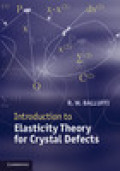
Ideal for graduates and researchers, this book provides a complete introduction to anisotropic elasticity, with exercises and solutions included. Assuming no prior knowledge, Introduction to Elasticity Theory for Crystal Defects provides a user-friendly introduction for graduates and researchers. Covering all the key topics, with mathematical complexities clearly explained, the readerwill gain a solid understanding of anisotropic elasticity theory. Exercises and solutions are included, making this the complete package. Assuming no priorknowledge, Introduction to Elasticity Theory for Crystal Defects provides a user-friendly introduction for graduates and researchers. Covering all the key topics, with mathematical complexities clearly explained, the reader will gaina solid understanding of anisotropic elasticity theory. Exercises and solutions are included, making this the complete package. Self-sufficient and user-friendly, this book provides a complete introduction to the anisotropic elasticity theory necessary to model a wide range of crystal defects. Assuming little prior knowledge of the subject, the reader is first walked through the required basic mathematical techniques and methods. This is followed by treatments ofpoint, line, planar and volume type defects such as vacancies, dislocations, grain boundaries, inhomogeneities and inclusions. Included are analyses of their elastic fields, interactions with imposed stresses and image stresses, and interactions with other defects, all employing the basic methods introduced earlier. This step by step approach, aided by numerous exercises with solutions provided, strengthens the reader's understanding of the principles involved, extending it well beyond the immediate scope of the book. As the first comprehensive review of anisotropic elasticity theory for crystal defects, this text is ideal for both graduate students and professional researchers. Advance praise: 'This is a very nice, self-contained and inclusive book. It should provide a foundation for the anisotropic elastic theory of defects and their interactions for years to come.' John Hirth, Ohio State University 'This is a wonderfulbook on the elastic foundations of point, line and surface defects in crystals. It is well written by a master experimental and theoretical craftsman who has spent a long professional life in this field. The mathematical coverage of crystal defects and their interactions unfolds in classic style.' Johannes Weertman, Northwestern University 'â€a provides a detailed and comprehensive presentation of the elasticity theory of crystal defects in full anisotropic form â€a a full understanding of the ranges of applicability of mechanisms often necessitates the use of anisotropic elasticity employing advanced mathematical methodology. Such methodology is presently available only in scattered journal publications going back many years or in special treatises using advanced mathematical language of a large variety of forms and often involve[s] frustratingstatements of 'it can be shown that'. In his book Balluffi provides detailed and compassionate developments, that skip little detail, permitting the readerto obtain a rare and penetrating view into complex methodology with a uniformmathematical language that is familiar to most advanced students and professionals â€a a standard reference for years to come [for] physicists, materials scientists and practitioners in applied mechanics.' Ali Argon, Massachusetts Institute of Technology INDICE: 1. Introduction; 2. Basic linear elasticity; 3. Methods; 4. Green's functions for unit point force; 5. Interactions between defects and stress; 6. Inclusions in infinite homogeneous regions; 7. Interactions between inclusions and imposed stresses; 8. Inclusions in finite homogeneous regions – image stresses; 9. Inhomogeneities; 10. Point defects in infinite homogeneous regions; 11. Interactions between point defects and stresses; 12. Dislocations in infinite homogeneous regions; 13. Interactions between dislocations and stresses; 14. Interfaces; 15. Interactions between interfaces and stresses; 16. Interactions between defects; Appendices; Index.
- ISBN: 978-1-107-01255-4
- Editorial: Cambridge University
- Encuadernacion: Cartoné
- Páginas: 458
- Fecha Publicación: 12/04/2012
- Nº Volúmenes: 1
- Idioma: Inglés
